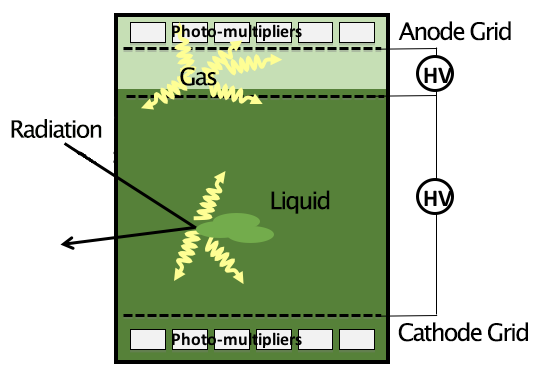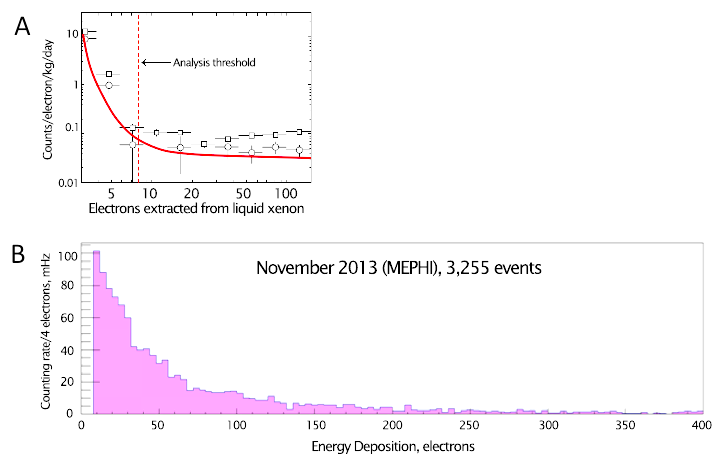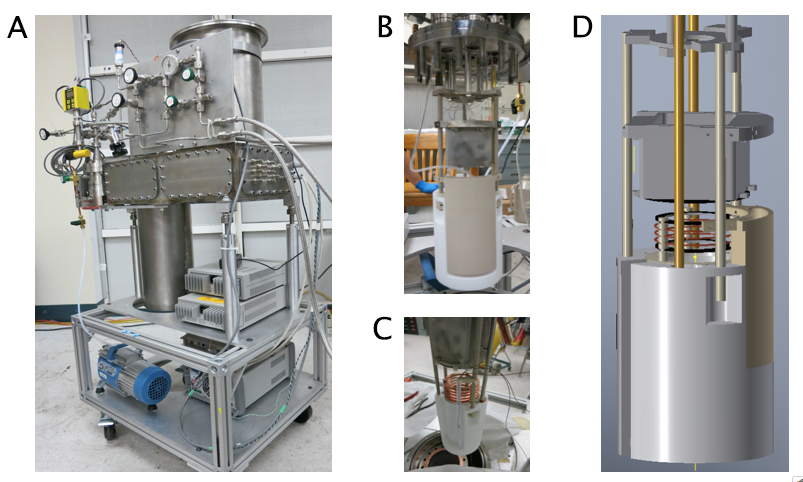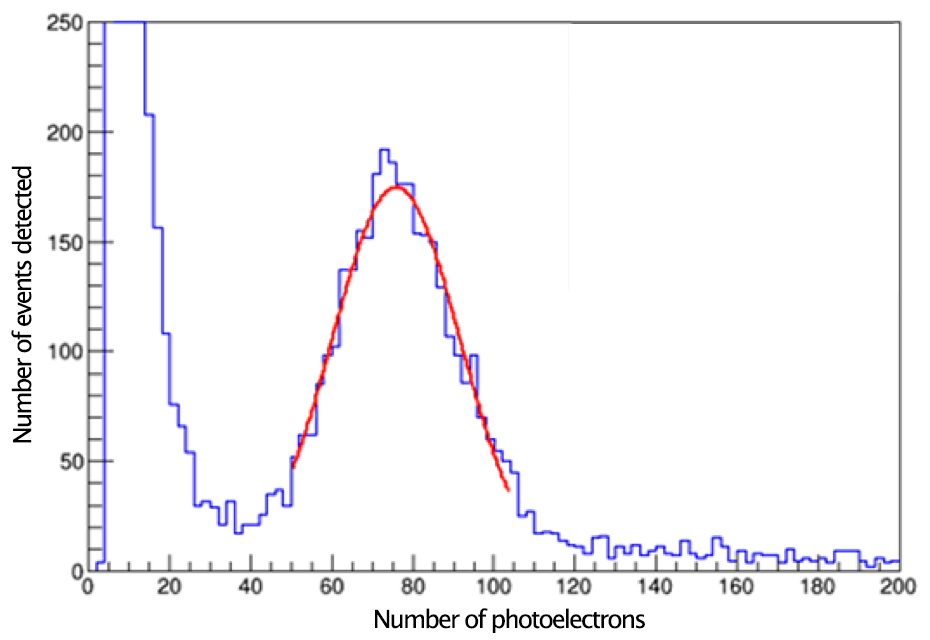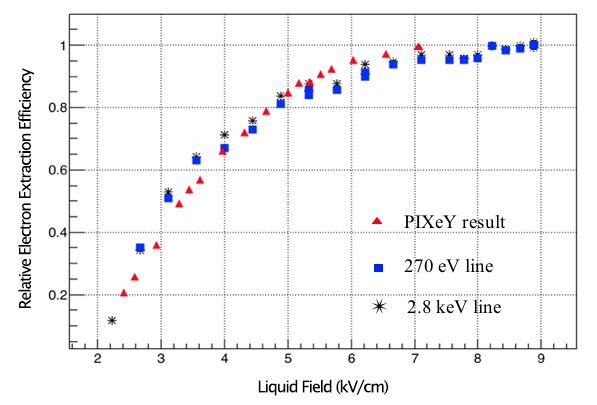Sergey Pereverzev (17-FS-029)
Abstract
While noble gas and liquid detectors are widely used and well understood, there is still room for improvement in their energy sensitivity and resolution. Further development is required to calibrate detector responses to low-energy events and to better understand device physics and device-generated noise at the very low-energy parts of spectra (i.e., few-electron events). The purpose of this project was to study detector response and noise in the presence of induced ionization in order to test a possible mechanism for noise generation that is largely unstudied and unquantified for this class of detector. To that end, we used an existing liquid-xenon dual-phase detector with suitable sensitivity in the low-energy regime. The specific hypothesis we investigated was whether few-electron noise (i.e., events consisting of approximately two to five electrons generated in the liquid) may arise spontaneously from metallic surfaces immersed in the detector's liquid volume. Few-electron noise can be affected by an extensive range of detector parameters, including gas amplification, efficiency of extraction of electrons from liquid into gas, the electrical field in the electron-drift region and on the surfaces of grids and electrodes, the ionization rate, and pulse amplitudes. Careful analysis of the data was required due to the many possible parallel mechanisms involved in background production.
Background and Research Objectives
Geiger counters, including noble gas ionization detectors, have been used by scientists for more than one hundred years. However, the energy sensitivity and energy resolution of these detectors need to be be improved. Our project focused on understanding parasitic (i.e., detector-generated) low-energy background in a dual-phase liquid xenon/liquid argon detector (see Figure 1).
Xenon and argon detectors, even those made out of low radioactivity materials and operating deep underground to diminish flux of cosmogenic muons, demonstrate unexpected background (i.e., events where very few electron–ion pairs are produced by primary particles) at low energies (see Figure 2). In this range (approximately one to ten electron pairs) there should be detection of signals from coherent scattering of low-energy solar neutrinos, hypothetical low-mass dark-matter particles, and coherent scattering of reactor antineutrinos. This method of detecting reactor antineutrinos can have practical application for reactor monitoring (Hagmann and Bernstein 2004; Akimov 2017).
Detecting the time delay between primary luminescence (S1) and gas electroluminescence (S2) enables measurement of the drift time of the electron signal to the liquid surface, from which the Z coordinate of the event may be derived (see Figure 1). For this reason, this type of detector is referred to as a time-projection chamber (TPC) detector. When the S1 light pulse becomes too small to be detected by the photomultiplier tube (PMT) arrays (because of the limited PMT quantum efficiency and modest light-collection efficiency), depth (Z) information is lost and only the X-Y coordinates of the primary event can be determined by PMT arrays using S2 light. This depth ambiguity is the main problem in separating true low-energy ionization events inside the bulk liquid from parasitic events on the liquid surface or on the surfaces of electrodes.
Scientific Approach and Accomplishments
To study the noise phenomena quickly and in a cost-effective way, we adapted an existing high-performance xenon dual-phase TPC located at Lawrence Livermore National Laboratory. To that end, we performed the following tasks:
- Identified requirements for our experimental set-up to be able to investigate the proposed noise mechanism.
- Made modifications to the set-up for measuring ionization yield of low-energy nuclear recoils to investigate noises and differentiate between different noise mechanisms.
- Collected and analyzed preliminary data confirming our hypothesis that few-electron noise may be generated on charged metal surfaces immersed in the detector's noble liquid.
- Performed specific modifications to the experimental apparatus that enabled us to explore a wider range of important physical parameters than has been possible in previous experiments. For example, generating a strong electrical field in the detector facilitated differentiation of different noise mechanisms and suppression of some of them simultaneously, thus significantly improving measurement of electron-extraction efficiency, an important goal of this project.
- Prepared experiments that would lead to developing simple mitigation strategies to suppress detector-generated background. This involved sending a high-voltage modulation signal to the detector to discharge charge-buildup on its metallic surfaces.
In developing a detector with improved energy sensitivity and resolution, we were confronted with the classical problem of large dynamic energy range: within a detector there may be strong ionizing events caused by muons and residual radioactivity where millions of electron-ion pairs are produced, but it is more desirable to detect smaller events when the detector has “calmed down” in the intervals between strongly ionizing events. If electrons are trapped and later released, or if energy is stored in some form and after delay a few new ions can be produced, a false low-energy event may be detected. While the appearance of “delayed” single electrons is almost impossible to exclude (for example, positive ion recombination on the cathode can release a single electron into the detector's liquid), appearance of correlated events containing as many as 20 electrons simultaneously at a rate above that of random coincidence of single-electron events is indicative of the presence of additional physical noise mechanisms that may be possible to suppress. If the dominant processes for generating correlated electron release can be identified and somehow suppressed, the low-energy background within a detector may be significantly increased to the level given off by low-angle scattering of environmental high-energy gamma (producing a flat spectrum at low energies) and beta sources (such as Ar39) dissolved in liquid (that also produces a flat spectrum at low energies).
There are several known sources of delayed or “parasitic” electron emission.
- Liquid–gas interface: Some electrons are trapped in electrostatic potential close to the detector's liquid surface (due to incomplete extraction) and can be released into gas with a measurable delay (or drift along the surface to the detector's walls).
- Impurities can be ionized by S2 light, producing delayed electrons. More complex electron-emission mechanisms may produce long-lived chemical radicals.
- Field emission may be caused by pin-like defects or chemical inclusions on the surfaces of metal electrodes.
The last two mechanisms can be suppressed with exceptional design measures. Trapped electron emission (i.e., evaporation) from the detector's liquid surface is generally believed to be non-correlated (i.e., electrons evaporate one by one). On the other hand, higher extraction efficiency should minimize the number of electrons trapped at the liquid–gas interface and their delayed “evaporation” into the gas. Extraction efficiency increases with the electrical field on the boundary, and an increase in efficiency from 90 to 99 percent should be crucial for suppressing this component of parasitic background.
Our experimental xenon set-up included a JT-type cryocooler to avoid vibrations of the cold head. Heat exchangers were also used to increase the rate of circulation through a gas-purification system in order to achieve total material recirculation in approximately two hours. All of the detector's fittings where designed to withstand low temperatures, to avoid outgassing from room-temperature plastic parts and internal cables.
We purposely limited modifications to this TPC detector to permit a detailed (but still preliminary) study of the noise sources in the detector (see Figure 3). We implemented the following changes to Livermore's xenon detector set-up for parasitic-background and condensed-matter studies.
- We shifted the cryocooler and heat exchanger from the top of the cold xenon experimental volume to the side to get direct access from the top to the experimental volume to install straight multi-functional high-voltage leads (HV components in Figure 1). This also enables the addition of optical access (planned for future work).
- We improved the carrying capacity of the high-voltage leads from approximately 12 kV (minimal requirement) to 30 kV (tested). We added the capability to send modulation signals by two separate wires in the same feed-through, so that we could apply a 1-kV amplitude AC signal at a frequency range of 100 kHz to 10 MHz, along with a DC bias of up to 30 kV.
- We implemented a modular design for all internal detector components so that each block could be individually changed or replaced with minimal effort.
- We encased the entire upper PMT detector array in a Faraday cage to prevent damage in the event of a high-voltage breakdown, and to enable data collection during a breakdown. The anode grid was attached to this block to facilitate an easy change-out of components, as well as to increase the distance between the anode and extraction grid.
- Liquid-level position was fixed by the position of the over-flow reservoir, thus allowing it to be easily adjusted.
- The electrical-field cage that defines the electrical field in active detector volume was designed to be easily removable and replaceable. All elements (cathode, field-shaping rings, and extraction grid) were also positioned to be easy to replace. (Note: Although we determined that it is possible to operate the detector without an extraction grid, this would have required a higher voltage at the cathode than we were able provide at the time.)
- We implemented low outgassing requirements for internal parts and high-voltage leads. Thanks to this and to high circulation and purification rates, we experienced no impurity-related problems. However, we cannot exclude the existence of some yet unknown synchronization mechanisms, such as capillary waves on the liquid surface that could create high-field regions and induce the release of correlated bursts of electrons.
Experimental Results, Observations, and Discussion
The extended range of our detector’s electrical fields and the flexibility in choosing gas-drift length it afforded allowed us to achieve the highest electron amplification (i.e., the number of photons detected by PMTs while electrons are drifting from the liquid surface to the anode grid; see Figure 4) for this type of detector. As well as good electrical-field homogeneity, it provides good energy resolution and electron-number resolution for low-energy signals; we were able resolve one, two, three, or more electrons coming out of detector’s liquid on a per-pulse basis. We were also able to differentiate pulses produced by few electrons drifting in the gas region from liquid surface to anode grid from photon pulses of different origins, such as S1 or S2 pulses generated outside of the active volume. These features are necessary for studying and understanding parasitic signals and background in the detector, and can also be used to suppress parasitic background by discriminating and removing “wrong” events.
As mentioned above, a high electron extraction efficiency in a large electrical field should lower the number of electrons trapped at the liquid–gas interface. We were able to measure the relative extraction efficiency in the large field range (see Figure 5). The relative extraction efficiency meant that the largest observed value was 100 percent. We did not measure the absolute extraction efficiency in this experiment. It appears that we may have reached saturation in our measurements. If we did in fact reach saturation of the electron-extraction efficiency, this would be a major milestone.
Using tools and capabilities we developed as a result of detector modifications implemented during this project, we attempted to measure the spectrum of low-energy detector response and background with different electrical fields in the detector, with and without lead shielding around the detector, and in the presence of collimated americium and cobalt sources outside the detector, in the presence of an Ar37 isotope inside the xenon detector (during calibration runs), and in the presence of a neutron flux (gamma particles from neutron shields also were present) from a deuterium (D–D) neutron generator. Note that this report omits details of large detector commissioning and characterization work that was done by our team and concentrates on results and observations important for understanding device-generated noise from few-electron events.
We also tried to compare background spectra when a small (approximately 0.3 kV/cm) electrical field of opposite polarity is present in drift space, so that electrons and ions produced above the extraction grid (or events originated on the liquid surface or at the extraction grid) are contributing to the measured spectra, but signals originated below the extraction grid do not. It is generally expected that efficiency of electron emission from the metal surface is rising with electrical field strength on metal surfaces. In this case, we should have measured a larger influx of positive ions to the cathode grid than for the extraction grid (geometrically grids are identical). However, electrical field strength on the cathode grid is approximately 10 times weaker on the side facing upward. The electrical field is stronger on the side facing downward. Electrons are also coming to the lower side from the liquid layer below the cathode (between the cathode and another grid at ground potential protecting the bottom PMT). Additional experiments are required to determine if ions on a wire's surface can move around the wire and to understand the process of recombination of ions and electrons (not electrons from metal) on the wire's surface.
For large gas amplification, PMTs start to saturate due to strong S2 signals, so the quality of position reconstruction of strong events degrades at high amplification. For small events, position reconstruction is generally slightly improved at high amplifications.
Spectra of low-energy background events (the absolute rate) are important to understand what signal level can be detected experimentally. We collected background data for different extraction and drift field with and without presence of radioactive sources. A range-of-time veto window was applied in calculating those spectra, to separate delayed electron emission, presumably due to electrons delayed for a short time at the liquid–gas interface. Application of the veto produces a different effect on single-electron rate and on the correlated (few-electron) event rate. Application of the veto decreased the rate of delayed single-electron events, while correlated few-electron events rates were less affected. Our interpretation is that the delayed single electrons are due to electrons “evaporating“ from the liquid–gas interface; correlated electrons likely originate from metal–liquid interfaces (metal grid surfaces) and continue to be emitted even after the veto window has been lifted.
We can conclude here that the xenon detector testbed we built allows us to conduct multiple qualitative experiments and quantitative measurements to eventually gain a good understanding of mechanisms responsible for parasitic low-energy background. In the future, we intend to work on optimizing detector performance for neutron scattering. We are also gathering data required for a better understanding of the low-energy detector background. If time allows, we will try more focused experiments on background, such as running the detector with different grid configurations and applying high-voltage modulation between grid wires. In configurations without the extraction grid, application of strong AC voltage between cathode wires is expected to decrease the number of correlated background electron events by letting positive ions near the metal surface to recombine faster, while this modulation will not change conditions for the electron trapped on the liquid surface. Increasing the DC electrical field strength should decrease the size and depth of the potential trap for electrons near the liquid surface, so “evaporation” of delayed electrons from the liquid surface should go faster. Potentially, combining both techniques, it may be possible to detect coherent scatter of reactor antineutrinos with the detector operating on the surface with moderate radiation shielding.
Impact on Mission
The Rare Event Detection Group at Lawrence Livermore National Laboratory participates in the LZ Dark Matter Experiment, which is aimed at direct dark matter detection with a large underground dual-phase liquid xenon detector. LZ has been selected by the DOE and the National Science Foundation as one of the three "Generation 2" dark-matter experiments. It is important for LZ to improve low-energy nuclear recoil calibration. It is also important to understand sources of low-energy background signals, both to lower detection limits for light dark matter particles and to develop capabilities to detect low-energy solar neutrinos or supernova neutrinos (Essig et al. 2012).
Another large liquid xenon-detector project in development is nEXO. It is aimed at the discovery of neutrinoless double-beta decay. While the energy regime of interest is about 1,000 times greater (MeV-scale versus keV-scale interactions), nEXO will also benefit from the experience and expertise we gain in building liquid xenon detectors in high-voltage application, xenon circulation and purification, handling emergency gas recovery, and other insights. The nEXO team has closely followed our activities and the lessons learned in our small but highly capable testbed.
Outlook and Prospects for Additional Work
In the course of our work, we have found that there could be a way to use information about the ratio of photons emitted by excited molecules in singlet and triplet states formed on the track of energetic particles to improve energy resolution in liquid xenon and other noble liquid detectors, as well as other scintillating detector types. This ratio can be found from the time dependence of luminescence intensity. In other words, a technique similar to pulse shape discrimination (which is used for particle identification) can be used to improve the energy resolution of scintillating detectors at high energies (relevant double beta decay in Xe). In principle, it may be possible to make the energy resolution of the liquid detector approach that of gas detectors with significant positive benefits to a wide range of problems in fundamental and applied science. This will be important for many other liquid argon or liquid xenon detector applications. This question requires a detailed discussion which goes far beyond the scope of the current project.
We have also demonstrated that with adequate machine shop/engineering support, our team can design and build unique systems that exceed, on many important parameters, similar systems built by our colleagues and/or competitors; no need to mention that we cannot get compatible commercial equipment. Still, making parts, and to a smaller degree, mechanical design remain the bottlenecks for small budget research and development projects.
We also demonstrated that small- or medium-size (several-hundred-kg active mass) dual-phase liquid Xe or liquid Ar detectors can be made transportable and capable of working autonomously in the field or at nuclear power plants as soon as several-kW electric power is provided. This moves the idea to use coherent scattering detectors for reactor monitoring to a higher technical readiness level.
In the longer term, the highest profile impact on Laboratory mission will be demonstration of detection of coherent scatter using reactor antineutrinos, especially if this can be done with a relatively small detector without radiation shielding that is too heavy. The present research provides important and positive input to this research problem.
Conclusions
Our techniques for suppressing parasitic low-energy background of dual-phase xenon (or argon) detectors and our effort to use those devices for detecting coherent scattering of reactor antineutrinos or low-energy solar neutrinos are gaining traction in the scientific community. In our opinion, the present understanding of surface phenomena and boundary phenomena in noble liquids and solids is insufficient for further development of liquid–liquid xenon and argon detectors; more basic research into condensed-matter physics needs to be done.
References
Akimov, D., et al. 2009. "Detection of Reactor Antineutrino Coherent Scattering Off Nuclei with a Two-Phase Noble Gas Detector." Journal of Instrumentation 4 (06). doi:10.1088/1748-0221/4/06/p06010.
———. 2017. "Observation of Coherent Elastic Neutrino-Nucleus Scattering." Science 357, no. 6356 (September 15): 1123–126. doi:10.1126/science.aao0990.
Essig, R., et al. 2012. "First Direct Detection Limits on Sub-GeV Dark Matter from XENON10." Physical Review Letters 109, no. 2. doi:10.1103/physrevlett.109.021301.
Hagmann, C. and A. Bernstein. 2004. "Two-Phase Emission Detector for Measuring Coherent Neutrino-Nucleus Scattering." IEEE Transactions on Nuclear Science 51, no. 5: 2151–155. doi:10.1109/tns.2004.836061.
Publications and Presentations
Pereverzev, S., et al. 2017. “Toward Detection of Coherent Scattering of Reactor Antineutrinos on Nuclei with Dual-Phase Xe or Ar Detectors.” Presentation at the CPAD Instrumentation Frontier Workshop, Albuquerque, NM, September 12–14. LLNL-PRES-739827.
   

